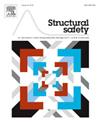结构信息保真度对区域风险评估降阶模型开发的影响
IF 6.3
1区 工程技术
Q1 ENGINEERING, CIVIL
引用次数: 0
摘要
降阶模型(ROMs)广泛用于地震易损性估计,既可用于近似特定结构的响应,也可用于在区域风险评估应用中对建筑物组合进行建模。不同的ROM建模方法具有不同程度的复杂性,建模选择以及估计响应的准确性自然取决于开发ROM的可用信息的保真度。对于区域风险评估应用,ROM实现通常使用自动化工作流来建立,该工作流利用有关基本建筑特征的通用信息来推导仿真模型的力学参数。本文研究了当在这种情况下使用rom时,信息保真度对下游风险分析的影响,特别关注抗矩框架(mrf)。首先,提出了一个建立具有滞后非线性行为的多自由度(mof) ROM的框架,建立规则集,从常用的建筑描述(如层数、层高、设计规范或结构系统类型及其材料(例如,钢筋混凝土或钢)中导出ROM参数的标称值。规则集强调显式地对故事之间的差异进行建模,而不是依赖于利用等效于非弹性单自由度系统的简化近似。通过在上述标称值上分配概率分布来量化用于开发ROM的信息的保真度,在不同参数上具有不同程度的不确定性。然后进行参数和全局敏感性分析,以调查该信息保真度的重要性。讨论了利用重采样原理的计算工作流,以提高这些分析的计算效率。研究结果为建立不同mof原型ROMs的关键参数提供了独特的见解,并为在区域尺度地震风险评估中部署ROMs时需要收集的数据类型提供了更高的保真度(置信度),以提高预测精度。本文章由计算机程序翻译,如有差异,请以英文原文为准。
Impact of structural information fidelity on reduced-order model development for regional risk assessment
Reduced-order models (ROMs) are widely used for seismic vulnerability estimation, both for approximating the response of specific structures as well as for modeling a portfolio of buildings within regional risk assessment applications. There are different ROM modeling approaches with different degrees of complexity, and the modeling choice, as well as the accuracy of the estimated response, naturally depends on the fidelity of the available information for developing the ROM. For regional risk assessment applications, the ROM implementation is commonly established using an automated workflow that leverages generic information about basic building characteristics to derive the mechanical parameters of the simulation models. This paper investigates the influence of information fidelity on the downstream risk analysis when utilizing ROMs in such a context, focusing specifically on moment-resisting frames (MRFs). Initially, a framework for establishing multi-degree-of-freedom (MDoF) ROMs with hysteretic nonlinear behavior is presented, establishing rulesets to derive nominal values of ROM parameters from commonly available building descriptions such as number of stories, story height, design specifications, or structural system type and its material(s) (e.g., reinforced concrete or steel). The rulesets place emphasis on explicitly modeling differences across stories instead of relying on simplified approximations that utilize equivalence to inelastic single-degree-of-freedom systems. The fidelity of the information for developing the ROM is quantified by assigning probability distributions over the aforementioned nominal values, with different degrees of uncertainty across the different parameters. Parametric and global sensitivity analyses are then performed to investigate the importance of this information fidelity. A computational workflow leveraging resampling principles is discussed to promote computational efficiency in these analyses. The results provide unique insights into the parameters of critical importance for establishing ROMs for different MDoF archetypes and offer guidance for the type of data that needs to be collected with higher fidelity (degree of confidence) when deploying ROMs in regional scale seismic risk assessment, in order to improve the prediction accuracy.
求助全文
通过发布文献求助,成功后即可免费获取论文全文。
去求助
来源期刊

Structural Safety
工程技术-工程:土木
CiteScore
11.30
自引率
8.60%
发文量
67
审稿时长
53 days
期刊介绍:
Structural Safety is an international journal devoted to integrated risk assessment for a wide range of constructed facilities such as buildings, bridges, earth structures, offshore facilities, dams, lifelines and nuclear structural systems. Its purpose is to foster communication about risk and reliability among technical disciplines involved in design and construction, and to enhance the use of risk management in the constructed environment
 求助内容:
求助内容: 应助结果提醒方式:
应助结果提醒方式:


